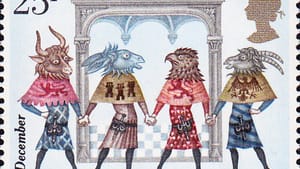Stay in the Loop
BSR publishes on a weekly schedule, with an email newsletter every Wednesday and Thursday morning. There’s no paywall, and subscribing is always free.
Songbirds and roasted birds
Piffaro presents 'Mummers' Delight'

Piffaro’s “Mummer’s Delight” concert ended with Mark Jaster and Sabrina Mandell miming a battle while Piffaro’s musicians played Renaissance war music behind them. Armed with plant stalks, the two actors mimicked archers firing at invisible enemies, then hurled the stalks at each other. Mandell fell with a clutch of arrows in her chest and the sequence ended with Jaster pondering his fallen enemy while the band played the somber strains of an Agnus Dei. In three or four minutes, with two actors and six musicians, Piffaro had run through all the emotions evoked by the battle of Agincourt.
The “Mummer’s Delight” title created some false expectations, at least for Philadelphians. The kind of acting Jaster and Mandell added to the program is, indeed, part of the grand tradition of mummery, one strand of which is enshrined in Philadelphia’s New Year’s Mummers Parade. But most of the program presented a more poetic form of mummery than the version displayed in front of the local TV cameras.
The concert was subtitled “A Renaissance Menagerie” and the musicians mostly played music composed by Renaissance composers who liked to imitate the sounds and movements of songbirds, animals, and insects. The creatures conjured up by the actors included nightingales, fluttering butterflies, heraldic roosters, and the warhorses who fought in the final battle scene. In one short section, Jaster imitated a hissing goose, the butcher who beheaded it, the chef who cooked it, and the servant who presented it on a platter. The familiar tune “Three Blind Mice” took on a tragic quality; the annotations in the program noted that it may have referred to the execution of three Protestant bishops during the reign of Mary Tudor.
Recreating street entertainment
The concert didn’t recreate a particular historical event, as some Piffaro programs do, but instead fit the music into the kind of role it played in its own time. The audience could have been watching a street troupe or a little light entertainment at a court fete. The people who heard this music when it was written didn’t listen to it in concert halls.
This was an ensemble event, but Priscilla Herreid deserves special mention for her lively, perfectly pitched evocation of the nightingale. She seems to have become Piffaro’s primary recorder soloist; she plays with a spirit and authority that make her one of the best musicians they’ve added to their ranks over the years. She holds a graduate degree in Baroque oboe, in addition to playing all the Renaissance wind instruments, and she was one of the oboists at Tempesta di Mare’s last concert.
The period instrument movement began near the end of the 19th century but it didn’t become a significant presence on the concert schedule until the 1980s. Piffaro’s older members all belong to that pioneering generation. Young musicians like Priscilla Herreid prove their resurrection of the past has a future.
What, When, Where
Piffaro, “Mummers’ Delight: A Renaissance Menagerie”: Music celebrating birds, animals, and insects by Pretorius, Sweelinck, other Renaissance composers. Mark Jaster, Sabrina Mandell, actors. Piffaro, the Renaissance Band, Joan Kimball and Robert Wiemken, artistic codirectors. March 18, 2016 at Trinity Center for Urban Life, 22nd and Spruce Streets, Philadelphia. 215-235-8469 or piffaro.org.
Sign up for our newsletter
All of the week's new articles, all in one place. Sign up for the free weekly BSR newsletters, and don't miss a conversation.
 Tom Purdom
Tom Purdom